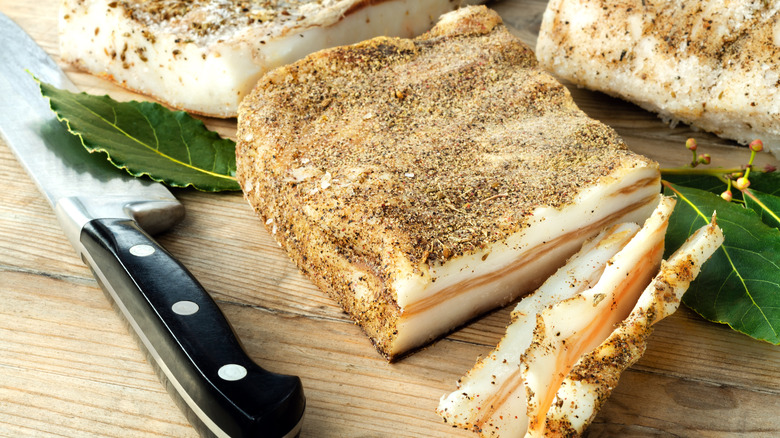Tuscany's Sliceable Lard Delicacy Has To Be Cured In White Marble Basins
If you're an experienced traveler and foodie, you have your favorite places to find the best Peking duck in Beijing or the simplest tacos al pastor in Mexico City – but it's when you stray outside of the tourist hubs and explore regional cuisine that you strike gold. This is usually where you can find the most delicious examples and gain an understanding of a country and its culture. Delve into regional Chinese food to discover Hainanese or Dongbei cuisines, or discover the diversity in flavor and method of Mexican food, from Pueblan mole to Yucatecan cochinita pibil, to Baja fish tacos. Italian food is just the same, and when you get away from the Neapolitan pizzas and Roman carbonaras, you find some real winners.
Tuscan food is one of the regional cuisines to seek out. There is, of course, panzanella, made with stale bread and tossed with olive oil, vinegar, and bright, summery vegetables like tomatoes and cucumbers, but don't miss out on pappa al pomodoro. The bread-tomato soup varies from town to town, but the essential ingredients are stale bread, tomatoes, and olive oil. If you're an adventurous eater, you can find lampredotto – a cow's fourth stomach – served on a broth-soaked bun with salsa verde. If you're looking for something familiar, you can't go wrong with potato tortelli, a ravioli filled with potato and served with a meat ragout. And while you're exploring Tuscany, be sure to seek out lardo di Colonnata.
The unique curing method has earned lardo di Colonnata protected geographical status
High in the Apuan Alps of Tuscany is Colonnata, home to Carrara marble (the one you lust after for your kitchen countertops or bathroom vanity) and lardo di Colonnata. What's unique about lardo di Colonnata is how the locals have used the abundance of marble to cure pork fat. The cut of lard is from the back of the pig, where there's not a lot of meat but plenty of fat (via Magnifico). It's rubbed with a mixture of salt, pepper, rosemary, and garlic before being placed in marble basins that have been rubbed down with garlic, and allowed to cure for six months at room temperature. The combination of Colonnata's mountain climate and the fine-grained, breathable marble is ideal for the curing process, which is what differentiates lardo di Colonnata from other cured Italian lardo. This method of curing lard in marble basins has been handed down from generation to generation, ensuring that the process and results are consistent and the same as they have been for centuries. This consistency – in both method and place – has earned lardo di Colonnata protected geographical indication status (via Great Italian Chefs).
Once cured, it's sliced thin and eaten many ways – on its own with olive oil or with an egg and shaved black truffles, and even on a pizza. The only problem with seeking out these regional delights is that once you're home and the craving strikes, you either find the best approximation, or it's a very expensive trip back.

